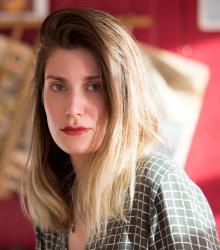Helga Thoroddsen’s first solo exhibition, ‘Fabularum’, is certainly one to see. It will be hosted by Listastofan, a gallery that has recently received a grant from the Department of Culture and Tourism and aims to work with up-and-coming artists like Helga, fresh out of university.
Helga was born in Selfoss, but received her education from London’s Camberwell College Of Arts. Her distinctive artwork celebrates female sexuality and empowerment through bright, vibrant paintings. She depicts both women she knows personally and celebrities like Lady Gaga, Madonna, and—of course—Björk. Her pre-Raphaelite style harks back to a time when the female image was often depicted as holy, virginal, and maternal: a beautiful but sexually innocent figure. In an interview with Reykjavík Fashion and Design, Helga explains how her love of beauty and the past helped shape her style: “In kindergarten, I drew pictures of my mum in a black dress because I thought she looked so beautiful in it. I also distinctly remember drawing mermaids and superheroes… During my studies in London, I was constantly within a proximity to the great works of antiquity. The National Gallery, Victoria & Albert Museum and all that. It had a profound impact on my work”.
The use of celebrities in lieu of the Virgin Mary or Christian angels, in these classical-style paintings, counteracts the archaic and sexist notion that women should be objects of sexual desire, whilst themselves remaining pure and sexless. Take Helga’s painting of Björk. She depicts the Icelandic singer in her famous swan dress, arm raised over her head, the other behind her back with crossed fingers, breast half exposed under the swan’s head, and a suggestive, wry smile on her face. She has no doubt been sexualised, but she is complicit in her sexualisation, and has power over it: she is no object. This, when combined with the classical style of the painting, an ode to beauty in its simplest form, creates an overall sense of empowerment. This figure is beautiful, sexual, desirable, but also commanding and formidable. Helga also uses “botanical symbolism of antiquity in its modern-day manifestation.” That is, she paints modern-day women holding pomegranates and pineapples, choosing the fruit as a reflection of the woman’s individual personality, rather than as a way of representing femininity as a whole, like the apple classical painters would use to symbolise the sin of female sexuality. Her work is a true celebration of women: of their individual spirit, and their right to be sexual beings.

Listastofan Gallery has a reputation for being a space where artists—especially young artists—can gather with the community to support and inspire one another. As Helga put it, “Listastofan allowed me to connect with other creatives and meet a bunch of wonderful people from all over the place. It is a very international family.” Certainly, it’s a place where Helga’s work, in all its reimagined, experimental glory, has been accepted with open arms. One thing is for certain: Helga is an artist to keep an eye on; we expect great things from her.
If you want to see Helga’s work, get yourself to Listastofan by March 15. The exhibition is open from Wednesday-Saturday 13:00-17:00.
Buy subscriptions, t-shirts and more from our shop right here!




















